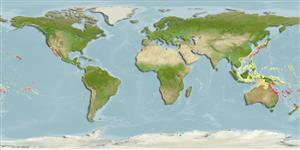Common names from other countries
Environment: milieu / climate zone / depth range / distribution range
Ecología
marino asociado a arrecife; rango de profundidad 2 - 35 m (Ref. 9710). Temperate
Distribución
Países | Áreas FAO | Ecosistemas | Ocurrencias, apariciones | Point map | Introducciones | Faunafri
Southwest Pacific: Australia and New Zealand. Range extends eastward to Easter Island (Ref. 9710).
Tamaño / Peso / Age
Maturity: Lm ? range ? - ? cm
Max length : 29.0 cm TL macho / no sexado; (Ref. 9710)
Espinas dorsales (total) : 8 - 10. Body color light brown with a faint blue spot, 1 per scale, above lateral line and 7 faint golden stripes following centers of scale rows below lateral line; a faint dark stripe from front of snout to eye with a fainter continuation behind eye; lower half of head pale silvery. Pectoral fin comparatively long (1.5-1.7 times in HL) (Ref. 9823).
Adults are primarily found in lagoons (Ref. 9710). Also in coastal reef areas. Feed on a variety of invertebrates. Females in groups of up to 80 or more, males territorial (Ref. 9710). Oviparous, distinct pairing during breeding (Ref. 205).
Life cycle and mating behavior
Maturities | Reproducción | Spawnings | Egg(s) | Fecundities | Larva
Oviparous, distinct pairing during breeding (Ref. 205).
Randall, J.E., 1972. A revision of the labrid fish genus Anampses. Micronesica 8(1-2):151-190. (Ref. 2677)
IUCN Red List Status (Ref. 130435)
CITES (Ref. 128078)
Not Evaluated
Threat to humans
Harmless
Human uses
Pesquerías: sin interés; Acuario: Comercial
Herramientas
Special reports
Download XML
Fuentes de Internet
Estimates based on models
Preferred temperature (Ref.
115969): 20.5 - 29.2, mean 28.1 (based on 2296 cells).
Phylogenetic diversity index (Ref.
82804): PD
50 = 0.5002 [Uniqueness, from 0.5 = low to 2.0 = high].
Bayesian length-weight: a=0.00977 (0.00470 - 0.02030), b=3.07 (2.89 - 3.25), in cm Total Length, based on LWR estimates for this (Sub)family-body shape (Ref.
93245).
Nivel trófico (Ref.
69278): 3.5 ±0.37 se; based on food items.
Resiliencia (Ref.
120179): Medio, población duplicada en un tiempo mínimo de 1.4-4.4 años (Preliminary K or Fecundity.).
Fishing Vulnerability (Ref.
59153): Low vulnerability (19 of 100).
